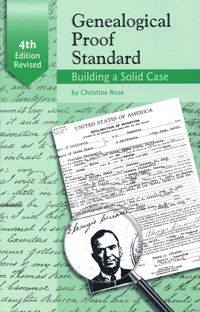In this blog, we have previously reviewed books and examined the topic of evidence as it relates to proving or supporting facts found in ones research. For example, two different sources indicate different marriage dates for an ancestor. How does the research identify which source is more accurate. Sometimes this involves an examination of the sources themselves. In other words, an evaluation of the evidence. In terms of the legal system, attorneys build cases on a principle called preponderance of evidence. Family historians build their own cases around evidence as well. The standard for building genealogical cases is referred to as the Genealogical Proof Standard. This is really less complicated than it sounds. Fortunately, Christine Rose has written the perfect primer on the subject, called Genealogical Proof Standard: Building a Solid Case. The Fourth Edition of this must-have genealogy guide was published in 2014.
This new fourth edition is being offered at 10% off through Wednesday, September 9, 2015 making it just $8.96; Reg. $9.95.
The first chapter jumps right in and explains exactly what the Genealogical Proof Standard actually is; including, the process and how to apply it. The book also covers when and why the standard should be used by researchers. Ultimately, the main point of the book is to help family historians use a structured and tested method for evaluating the veracity of records and information. The book is short, only five brief chapters. Yet, the measure of its worth is in the return one sees in applying these concepts to their own genealogical research.
Table of Contents
Introduction
Chapter 1: What is the Genealogical Proof Standard?
- Applying the Standard
- GPS: The Process
- How Research is Evaluated
- Criteria to Consider
- Original, Derivative, and Authored Sources
- Distance in time
- Primary, Secondary, and Indeterminable Information
- Importance of identifying the informant
- Primary information generally carries more weight than secondary or indeterminate information
- Secondary information
- Direct, Indirect, and Negative Evidence
- Categorizing the evidence
- Weighing the Assembled Evidence
Chapter 2: Building a Solid Case
- When to Use GPS
- Situation 1
- Situation 2
- The Important “Who”
- Additionally, Consider the “Why”
- Situation 3
- Cautions Emphasized
- Items of Contradicting evidence
- What to do when opposing evidence is not refuted?
- Chart: Building a Solid Case with the GPS, the Process
- To Reach a Conclusion in Problem Cases
Chapter 3: Evaluation the Records
- Census Records
- Tombstones
- Multiple sources don’t match
- Military Records
- Death Records
- Marriage Records
- Birth Records
- The Internet
- Family data on the Internet
- Published family histories
- Getting Hung Up
- Not all questions or problems are solved
Chapter 4: Case Studies
- Analyzing the Criteria
- John Smith [Hypothetical Case]
- Bennet Rose [Actual Case]
- Analysis of Evidence
- Conclusion
- Continued Testing
- Summation
Chapter 5: Writing it Up
- Proof Summary, Proof Argument and Proof Statement
- Proof Summaries
- Proof Summary: List-Style and Narrative-Style
- Proof Arguments
- The Narrative
- Proof Statements
- Purpose of Written Summaries/Conclusions
Epilogue: Final Words
Suggested Sources
Index
Genealogical Proof Standard: Building a Solid Case is available from Family Roots Publishing; Item #: CR0001, FRPC Sale Price $8.96 – through Wednesday, Sept. 9, 2015; Reg Price: $9.95.
